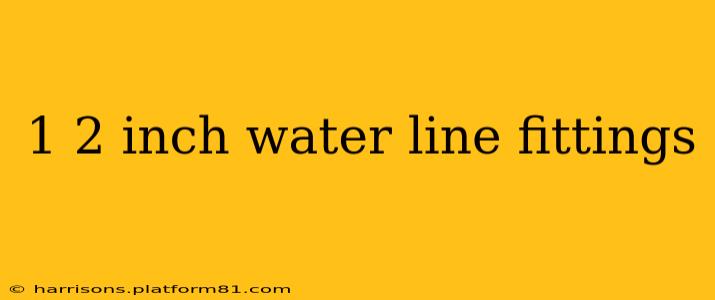Finding the right fittings for your 1 1/2-inch water line is crucial for ensuring a safe, efficient, and long-lasting plumbing system. This guide will walk you through everything you need to know about 1 1/2-inch water line fittings, from the different types available to choosing the best ones for your specific needs.
What Types of 1 1/2 Inch Water Line Fittings Exist?
A wide variety of fittings are available for 1 1/2-inch water lines, each designed for specific purposes and applications. Understanding the differences is vital for selecting the correct fitting for your project. Common types include:
- Couplings: Used to connect two lengths of pipe of the same diameter. These are essential for extending water lines.
- Elbows: Change the direction of the water line by 45, 90, or other angles. They are critical for navigating obstacles and creating efficient plumbing layouts.
- Tees: Create a branch point in the water line, allowing for the addition of another pipe or fixture. This is commonly used for splitting a line to multiple outlets.
- Reducers/Adapters: Connect pipes of different diameters, such as connecting a 1 1/2-inch pipe to a 1-inch pipe. This is necessary when transitioning between different pipe sizes.
- Caps: Seal the end of a pipe, preventing water leakage and providing a clean finish.
- Unions: Allow for easy disconnection and reconnection of pipe sections without having to cut or unscrew the entire line. This is exceptionally handy for maintenance or repairs.
- Nipples: Short pieces of pipe used to connect other fittings, bridging short gaps.
What Material Are 1 1/2 Inch Water Line Fittings Made Of?
The material of your fittings significantly impacts their durability, corrosion resistance, and overall lifespan. Common materials include:
- Copper: Known for its strength, durability, and resistance to corrosion, copper is a popular choice for water lines. Copper fittings provide a long-lasting solution.
- CPVC (Chlorinated Polyvinyl Chloride): A durable plastic alternative to copper, CPVC fittings are resistant to corrosion and chemicals, making them suitable for a wide range of applications. They are often more cost-effective than copper.
- PEX (Cross-linked Polyethylene): Flexible plastic tubing with fittings that use compression, crimp, or push-to-connect methods. PEX is known for its ease of installation and resistance to freezing.
Where Can I Buy 1 1/2 Inch Water Line Fittings?
1 1/2-inch water line fittings are widely available at various retailers, both online and in brick-and-mortar stores. Some common places to find them include:
- Home improvement stores: Large chains like Home Depot and Lowe's carry extensive selections.
- Plumbing supply stores: Specialized plumbing stores often have a wider variety and can offer expert advice.
- Online retailers: Amazon and other online marketplaces offer convenient purchasing options, although verifying product quality is essential.
How Do I Choose the Right 1 1/2 Inch Water Line Fittings?
Selecting the correct fittings depends on several factors, including:
- Pipe material: Ensure the fittings are compatible with your pipe material (copper, CPVC, PEX).
- Application: Choose the appropriate fitting type based on your needs (coupling, elbow, tee, etc.).
- Pressure rating: Select fittings with a pressure rating that meets or exceeds the pressure in your water system.
- Quality: Prioritize reputable brands known for their durability and reliability.
What are the Different Pressure Ratings for 1 1/2 Inch Water Line Fittings?
Pressure ratings are critical for safety and ensuring the fittings can handle the water pressure in your system. Ratings vary depending on the material and manufacturer. Always check the manufacturer's specifications to confirm the fitting's suitability for your water pressure. Ignoring this can lead to leaks and potential damage.
What is the Difference Between Compression and Push-to-Connect Fittings?
Compression fittings use compression rings to secure the connection between the fitting and the pipe. Push-to-connect fittings, typically used with PEX, rely on a clamping mechanism that seals tightly when the pipe is pushed into the fitting. Both offer reliable connections, but their installation methods differ.
Are 1 1/2 inch water line fittings expensive?
The cost varies considerably depending on the material, brand, and type of fitting. Copper fittings tend to be more expensive than plastic alternatives. Buying in bulk can often lead to lower per-unit costs.
This comprehensive guide should help you navigate the world of 1 1/2-inch water line fittings. Remember to always prioritize safety and choose high-quality fittings to ensure a durable and reliable plumbing system. If you are unsure about any aspect of your plumbing project, consult a qualified plumber.
